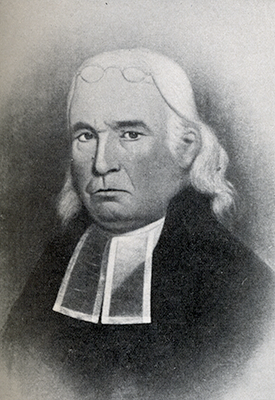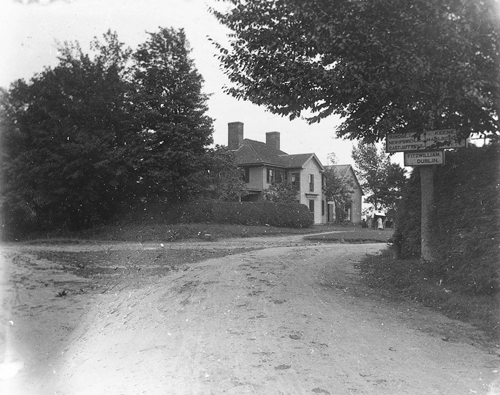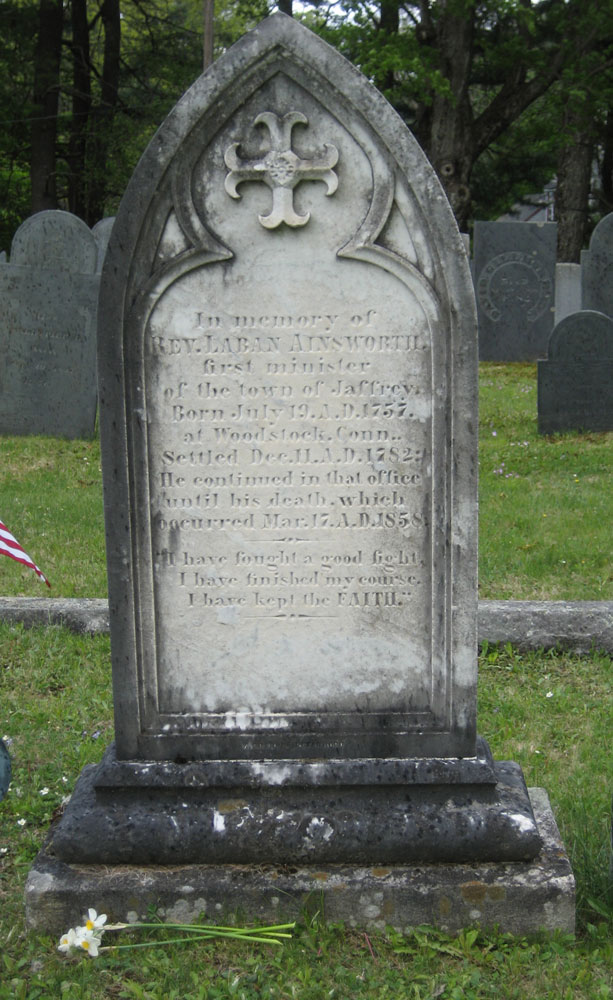Laban AinsworthLaban Ainsworth was born in Woodstock, Connecticut, July 19, 1757. In his childhood he suffered a severe attack of scarlet fever which caused his right arm to wither and to be nearly useless to him for life. This disability, which barred him from many of the active pursuits of life, probably led to his education for the clerical profession. It was intended that he should enter Harvard College in 1775, but, owing to the military situation around Boston at the time, he was sent to “Dartmouth in the woods,” where he entered the Sophomore class, and was graduated in 1778. He studied theology under Rev. Stephen West, D.D., at Stockbridge, Massachusetts, and while still under tuition he preached for two years at Spencertown, in the District of Claversack, on the Hudson River, where he served a few months as chaplain with Major McKinstry’s Corps in the Revolutionary Army. Having become established in his profession and in the confidence of the people he served, he was married, December 4, 1787, to Mary Minot, daughter of Jonas Minot, Esquire, of Concord, Massachusetts. During the preceding year, he had been engaged in all the time that could be spared from the duties of his profession, in building his house which he hoped might be his permanent home. The people of Jaffey, sharing in his anticipated happiness, had lent their aid in every possible way in providing and furnishing his new home.
Directly after their marriage, Mr. Ainsworth and his bride came on horseback to Jaffrey, and, when nearing their destination, were met by a cavalcade of parishioners and escorted to their new home. As they approached the house, they found the towns people assembled in a company which opened to the right and left as they were escorted between lines to the door. “Within everything was in perfect order. Fires were lighted and tables were furnished in the most generous style, so the day and evening were passed in gladness and social delight.” Mrs. Ainsworth was the descendent of a family noted for high character and thrift, and she inherited the fine qualities which immediately gained for her the confidence and esteem of the townspeople, which she retained throughout life. Bust with the best of prospects for comfort and happiness, the great tragedy of their lives was not far away. On the night of the 12th of the following February, they were awakened in the night by smoke and found their house in flames. In leaping from their chamber window, Mrs. Ainsworth received an injury from which she never fully recovered, and, saddest of all, Isaac Spofford, a child of eight years of age, son of Deacon Spofford, who was visiting Mr. and Mrs. Ainsworth, lost his life in the flames. The deepest sympathy was aroused for the young minister and his wife in their distress and a town meeting was called to provide means for their relief. At this town meeting it was voted to call on the people for donations, and five influential men wee chosen to circulate subscription papers among the inhabitants of the town. The response was generous and a committee, the strongest that could be named, was appointed to direct the work of rebuilding. Labor and materials were freely given and the united efforts of pastor and people soon resulted in the dignified and substantial Ainsworth Manse, which has been in the possession of the first minister of the town and his descendents from its erection to the present time. Laban Ainsworth fulfilled the promise of the engaging personality that had recommended him so strongly to the Jaffrey committee at the Dartmouth Commencement. He found equal favor with the people of Jaffrey in the probationary period of his preaching. Living conditions were then crude beyond our present conception, yet he offered no criticism and found no fault. The Revolution was still in progress and often he had to take his pay in promises that waited long for their realization. But times changed with the new century and prosperity came to pastor and people. Without detracting from the divinity that hedged a minister of the old days, Laban Ainsworth entered into the everyday life of his people. He bought and sold and bartered with them. He was and extensive owner of real estate. He cleared away forests, grubbed out stumps, fenced mountain pastures, loaned the fruits of his thrift to those less fortunate on real estate mortgages. He went hunting and fishing, shot foxes and bears. He belonged to the Masonic Fraternity and Liberty Society; he debated with the schoolmaster before the Washington Benevolent Society; he was superintendent of schools; he visited the sick and the well; he catechized the children, he knew the fathers and their children unto the third and fourth generations. He was fixed in his religious beliefs and yet was tolerant of the opinions of others. He advised in town meeting and no one’s counsel carried greater weight. He was a business man but the title of Parson came first. In the old sense, he was above all the shepherd of his flock. As he grew older, his people called him Father Ainsworth. Some times they called him priest, which to them bore the same meaning, but parson, not minister, was the accepted term of endearment and respect. He had a keen sense of humor and could bandy words or play harmless practical jokes with the best of them. He was addicted to the weed, that is, he was a prodigious chewer of tobacco, a social accomplishment that had its uses in the argumentative circle before the tavern fire, but, withal, he had a profound sense of the dignity of his office and was ceremonious to a degree unapproached in these latter days. Additional ResourcesTenney, L. (1858). The Retrospect and the Anticipation of the Believer: A Sermon, Preached at the Funeral of the Rev. Laban Ainsworth, at Jaffrey, N.H., March 20, 1858, Press of T.R. Marvin & Son. Retrieved on March 10, 2013. |

Portrait of the Rev. Laban Ainsworth.
|


